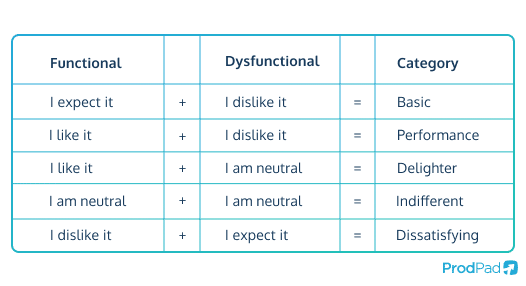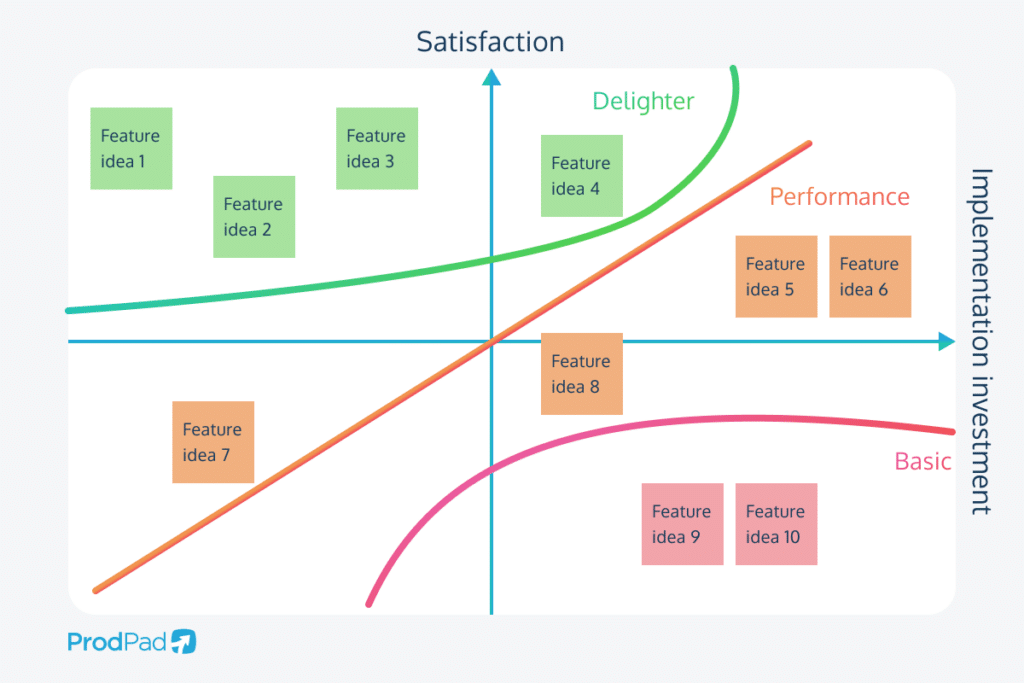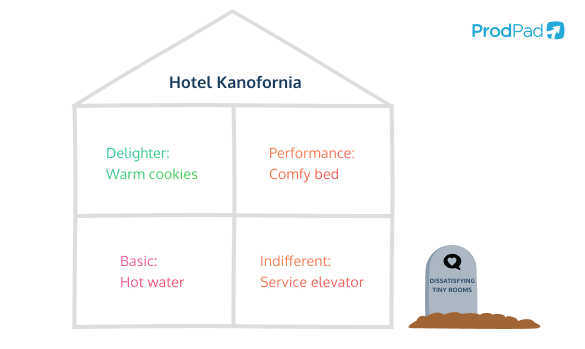Kano Model
What is the Kano model?
The Kano model is a prioritization framework that focuses on what will satisfy and delight your customers, and what you need to include in your product to meet their basic needs. It separates your product’s features into five categories based on how customers will react to them and can help you to determine which features are worth investing your resources in.
The Kano Model was developed by Noriaki Kano in the 1980s. Kano’s research challenged traditional ideas around customer satisfaction. He argued that satisfaction was not a linear process, but rather a complex range of emotional responses that could be categorized into five different types of features.
Using the Kano Model can help you as a product manager to make decisions about which features on your product roadmap will have the greatest impact on customer satisfaction, and which ones are a waste of effort. It can also point you towards opportunities to impress your customers with unexpected functionality that exceeds their expectations.
The Kano model can help you to determine:
- Which basic features you must include when entering the market
- Which performance features your customers are looking for
- Which attractive features will delight your users when they come across them
- Which indifferent features your customers won’t really care about
- Which dissatisfying features you should get rid of

How does the Kano model work?
The Kano model uses a standardized questionnaire to gather specific customer feedback about your product. The survey uses positive, functional questions, and negative, dysfunctional questions to determine how your users feel about each issue. It uses the following five-point scale:
- I like it
- I expect it
- I am neutral
- I can tolerate it
- I dislike it
Functional questions ask how users would feel about a certain feature being implemented. For example, you could ask “How would you feel about adding PayPal integration into our checkout process?”
Dysfunctional questions ask how your customers would feel if a certain feature was not available. For example, you could ask “How would you feel if we don’t add PayPal integration into our checkout process?”
You then use this feedback to determine which of your product’s current or prospective features are most important to their sense of satisfaction, and what they care or don’t care about.

Next, using the table above and the responses to your survey, you assign each of the features to one of these categories:
- Basic features
- Performance features
- Delighter features
- Indifferent features
- Dissatisfying features
You can then use these categories to decide what your users expect to be there, what will make your product stand out from the competition, what considerations you can safely ignore, and what you should knock off your feature list.
Features won’t stay in any one category forever, however. Something that starts out as a delighter can eventually become a basic expectation, and you can’t expect what has worked for you so far to always work in the future.
The five categories of features in the Kano model
1. Basic features
Also called “must-be features”. These are basic necessities that customers expect from any product in a particular category. Failure to meet these expectations will result in high levels of customer dissatisfaction, making these features the baseline for any product entering the market. Conversely, meeting just this basic level of expectation alone won’t satisfy your customers.
2. Performance features
Alternatively known as “one-dimensional features”. These are features that directly impact how well a product performs, and are often the focus of traditional product development processes. They are what your customers are specifically looking for and will be happy to find in your product, and are what you’ll need to include to ensure you’re keeping up with your competitors.
The better these features perform, the happier your customers will be. Again, simply meeting performance expectations alone, or even exceeding them, is not enough to fully satisfy customers.
3. Delighter features
Sometimes called “attractive features”. These are unexpected features that delight customers and give businesses a competitive edge. While they are not necessary for the basic functioning of a product, these features make it more desirable and lead to increased customer satisfaction.
For example, product design features such as an aesthetically pleasing color scheme or a heated car seat would fall under this category. They are the sort of features that your customers never realized that they wanted until you provided them, and the ones that will give you a competitive advantage.
4. Indifferent features
These are features that have little impact on customer satisfaction either positively or negatively. They are viewed as irrelevant comforts or are the sort of thing that goes unnoticed by your customers, such as additional product packaging, minor design changes, or certain technical specifications. While these features may be nice to have, they are not critical to customer satisfaction and may not influence their purchasing decisions.
5. Dissatisfying features
Alternatively referred to as “reverse features”, these actually decrease customer satisfaction the more they are implemented. For example: an overly complicated and difficult-to-use interface; unnecessary and confusing features; or poor customer service. By understanding and avoiding reverse features, you can focus on delivering the type of feature that your customers truly value and that will lead to a positive customer response.

A practical example of how the Kano model works
Here’s a useful example, adapted from our very helpful eBook The Product Manager’s Guide to Prioritization Frameworks:
Take a hotel. You expect a hotel to have hot water, even if it were a 1- or 2-star dump. That’s just a basic expectation. However, having hot running water on demand is actually quite a high bar in terms of investment, if you think about all the plumbing involved. If you went to a 5-star hotel but they didn’t have hot water, no matter how good the rest of it was, you’d hate that place as it doesn’t meet minimum expectations.
Next, consider what you’d expect the average hotel to have, things like a comfortable bed, a reasonably spacious room, a good breakfast, and decently fast internet. While none of these things are going to wow the hotel’s guests, the better each one is the happier they will be with how the hotel is performing its expected functions.
Now, take somewhere like Doubletree, a middle-of-the-road hotel. It has hot water, nice rooms, and the expected amenities. Nothing particularly special, but enough to be considered a solid 3-star hotel. But they have a delighter that makes them stand out in reviews: at check-in, they give everyone warm chocolate chip cookies, and it’s delightful.
However, other hotels are wising up to this and starting to provide little treats upon check-in too. At one point in time, having little bottles of shampoo and lotion and sewing kits in the room was a delighter, and now it’s a basic expectation. At some point in the future, we’ll all expect treats to come with check-in. So hotels will have to think of new, innovative delighters to replace ones that have become performance attributes or basic features.
When running a hotel, the managers and staff will be aware of the nuts and bolts of the place that help it to run properly. These are the sort of things that go unnoticed when they are working properly, like having a service elevator for staff rather than forcing them to tramp up flights of stairs. However, if the hotel’s guests knew about them, they would be indifferent, as they wouldn’t have a noticeable impact on their stay.
Finally, there are aspects of a hotel that might be considered features, but if they are taken too far will actually lead to dissatisfied customers. For example, a capsule hotel is often a cheaper option, though you will have to accept a very small room and probably limited facilities.
However, the smaller the room gets the more cramped and uncomfortable it will be, and the more upset the people staying there will be. And if the room is still too expensive compared to other options, then what would normally be a standard feature for similar hotels will be one that causes dissatisfaction here.

Pros and cons of the Kano model
While the Kano model can be a very useful prioritization tool with a number of benefits that can help to understand what your customers want and don’t want, it is far from the be-all and end-all in terms of frameworks.
It’s important to understand the pros and cons of using the Kano model so that you can determine which other prioritization frameworks you might need to incorporate into your process. This will help you to avoid tunnel vision and ensure you address a range of concerns rather than being overly focused on just the customer response to your features.
Benefits of using the Kano model
There is a reason that the Kano model is still in use despite being decades old. When managed properly, it is an effective method of finding the best ways to end up with satisfied customers.
The Kano model can help you to:
- Identify and prioritize customer needs and wants
- Discover insights into which features or attributes will provide the most value to customers
- Increase customer satisfaction and loyalty
- Save time and money by efficiently targeting your resources
- Identify potential areas for innovation and differentiation from your competitors
Drawbacks to using the Kano model
Despite offering a number of useful benefits, the Kano model is certainly not without its downsides.
The Kano model’s weaknesses include issues such as:
- Its scope is limited as it focuses on customer needs, without considering other potentially important factors
- Its results can be open to interpretation, which can lead to inconsistencies in how product teams use the model to inform decision-making
- It doesn’t take into account the cost and feasibility of adding features to your product
- It can be difficult to apply in practice, as different customers may have different expectations for the same feature
- It provides qualitative, numerical data that doesn’t explain why a feature is important or not
- It may not account for cultural or regional differences in customer preferences
Best practice advice and tips for Kano analysis
Prioritize getting your basic attributes and performance attributes sorted, then use delighters to differentiate your product from others in the market.
Make sure to revisit your analysis regularly as customer needs and preferences can change over time. A product feature that starts as a delighter will eventually become a performance feature, and possibly even a basic expectation as the market evolves.
Just because a feature is ‘indifferent’ in terms of the level of satisfaction it will provide to your users, that doesn’t mean you should automatically ignore it. If it makes life easier for your product team or developers, then it’s by no means useless, even if it won’t drive improved customer responses.
It’s worth remembering that no single prioritization framework will provide all of the answers. They are best used in combination so that you can garner insights into different aspects of the product development process.
By following these tips, your team can effectively use the Kano Model to design products that meet and exceed customer expectations, giving you a competitive edge and more loyal customers.
Further reading
Which Prioritization Model Is Best for My Product? – ProdPad’s CEO and co-founder Janna Bastow gives a rundown of four more task management tools, and how to pick the right one for your product.
Prioritization in Product Management – Our guide to the product management process from start to finish, and how ProdPad can help you to get on top of your backlog.